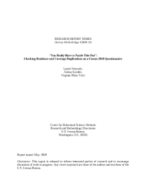
An official website of the United States government
Here’s how you know
Official websites use .gov
A .gov website belongs to an official government organization in the United States.
Secure .gov websites use HTTPS
A lock (
) or https:// means you’ve safely connected to the .gov website. Share sensitive information only on official, secure websites.
-
//
- Census.gov /
- Library /
- Census Working Papers /
- Checking Residence and Coverage Duplications on a Census 2010 Question
“You Really Have to Puzzle This Out”: Checking Residence and Coverage Duplications on a Census 2010 Questionnaire
“You Really Have to Puzzle This Out”: Checking Residence and Coverage Duplications on a Census 2010 Questionnaire
Abstract
The census must count everyone living in the United States just once and in the right place. This is a challenge in our diverse, mobile society: Census 2000 had an estimated 5.8 million duplicated persons (Mule 2002). Following the NAS Residence Rule Panel suggestion (NAS 2006) to try to identify duplications on the census form itself, the Census Bureau designed a 2010 Alternative Questionnaire Experiment overcount questionnaire to identify persons' alternate addresses and collect the residence rule data needed to indicate the address where they should be counted. This should make it possible to determine the right place to count persons with alternative addresses from answers on the census form itself during processing, rather than in a later telephone followup operation. This paper presents results of cognitive testing and coverage research with this experimental overcount census form in household types prone to duplication. During the debriefing, we also elicited descriptions of household members' living situations to check the extent to which patterns of answers on the questionnaires did identify persons’ correct residences. We discuss respondent comprehension of the overcount question. We then assess how well the overcount sequence worked to distinguish those who did and did not “sometimes live or stay somewhere else” and recommend revisions to question wording and to the skip instruction. We then assess whether the questions worked to identify the person’s correct residence, based on living situation information from the debriefing. We identify the types of individual and household living situations and mobility patterns that the question sequence picked up and those that were missed. We found that the experimental overcount sequence accurately identified the correct place for 12 of the 16 persons with two or more places. It also identified some persons with false negatives that would need followup to resolve. Based on these results, the experimental Census 2010 Overcount Questionnaire worked well in providing enough data to determine residence for most rostered persons who sometimes live or stay somewhere else. It has the potential to improve the Census Bureau’s ability to count persons once, in the right place, at lower cost and in less time.
Others in Series
Working Paper
Working Paper
Working Paper
Share
Related Information
Some content on this site is available in several different electronic formats. Some of the files may require a plug-in or additional software to view.
 Yes
Yes
 No
NoComments or suggestions?


Top

